Cosmos: the first blood
Purpose and objectives of the mission: Orbital rendezvous and docking with Soyuz-2
Date: 24 April 1967
Crew: Vladimir Mikhailovich Komarov (2-th flight)
Call Sign: Diamond
Cause of crash: Parachute system malfunction
Cause of death: Overloads incompatible with life when hitting the ground.
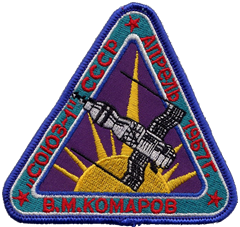
The Vostok spacecraft, which provided the Soviet Union with superiority in space, and its modification Voskhod-1 and Voskhod-2, could not solve the ever-increasing tasks of the space industry. The maximum that was available to these ships was to enter low orbit and remain on it for several days. For active work in space (changes in the height and inclination of the orbit, rendezvous and docking), these ships were unsuitable, and without these qualities, the flight to the Moon and the creation of space stations was impossible. Complete abandonment of the Voskhod program in order to concentrate resources on the USSR Lunar program, left the country without any suitable manned spacecraft suitable for flight. A new ship was required.
The design began during the life of the general designer, Sergey Korolev, and was continued after his death by Valentin Mishin. Initially, the Union was developed in two directions: the programs "Probe 7K-L1" (Lunar ship) and "7K-OK" (Orbital ship), a multi-purpose manned spacecraft, which later became the "Union".
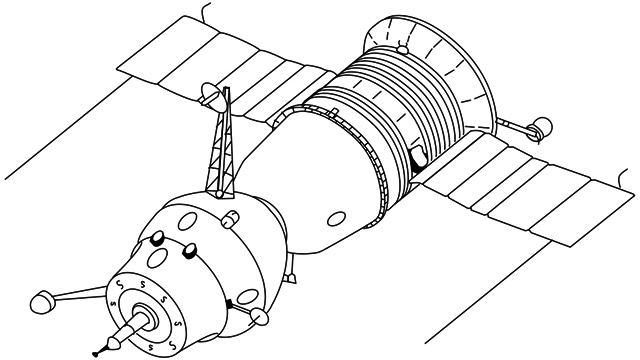
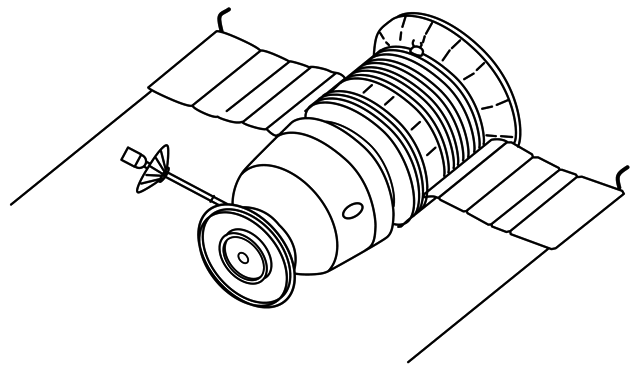
Flight tests of “7K-OK” began in 1966 year and went no matter, “7K-OK No. 2”, aka “Cosmos-133”, was launched on November 28 1966 of the year and the calculated orbit was successful, but the orientation system was installed incorrectly with confused polarity. As a result, commands from the ground were also executed inverted, in combination with the increased fuel consumption of the orientation system, the ship became virtually uncontrollable by the 20 turn. It was originally planned to conduct an unmanned docking with "7K-OK No. 1", but the launch had to be canceled. "7-OK number 2" was sent to the landing, but the descent capsule went into the non-calculated landing area in China. The USSR command could not allow the leakage of materials on the space program abroad, and the ship was blown up. The following test launch “7K-OK No. 1” turned into a catastrophe: just before the launch, the ship’s emergency rescue system suddenly worked, the spacecraft was not damaged, but the fire that broke out as a result completely destroyed the rocket and the launch pad. The third test “7K-OK No. 3” “Cosmos-140” flew 7 February 1967 of the year, the flight was partially successful, but when it entered the atmosphere due to an incorrectly installed technological plug in the heat shield it burnt a hole the size of 30 centimeters. The ship landed on the surface of the frozen Aral Sea, melted ice and sank. NASA from March 1965 to November 1966 conducted ten manned flights under the Gemini program, for the first time in the world having carried out orbital maneuvers, ships coming closer and orbital docking. Therefore, despite a number of failures with unmanned ships, and under great pressure from management, it was decided to make the following two launches of Soyuz-1 and Soyuz-2 manned. At the same time, Komarov was appointed commander of the Soyuz-1 spacecraft.
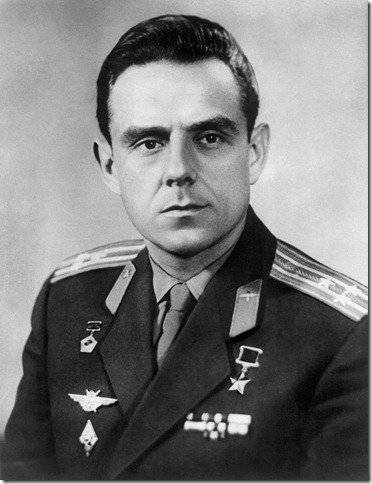
Prior to being admitted to the cosmonaut corps, Komarov made a career as a military pilot as part of the 382nd Fighter Aviation Regiment (IAP) of the 42nd Fighter aviation Air Force divisions of the North Caucasus Military District in the city of Grozny. From October 27, 1952 to August 1954, Vladimir served as a senior pilot of the 486th IAP of the 279th IAD of the 57th Air Army (VA). Despite the heavy load of pilot work, he managed to get a higher education. In 1959, he successfully graduated from the 1st faculty of the Zhukovsky Air Force Academy and was assigned to the State Red Banner Scientific Research Institute of the Air Force, where his work as a test pilot begins.
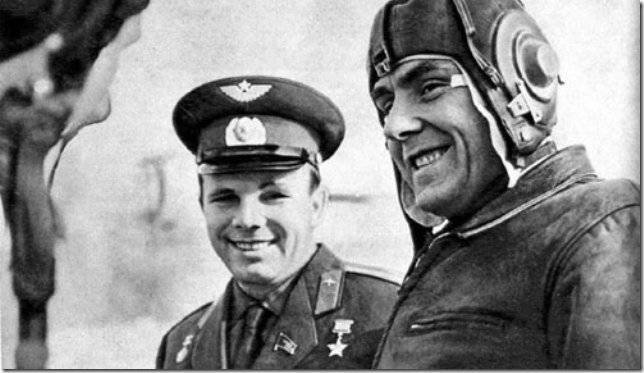
It was here that the commission to select the first cosmonaut corps offered Vladimir Komarov a new secret test work, and in 1960, he was enlisted in the cosmonaut corps (Air Force Group No. 1). Here Komarov meets Yuri Gagarin, they quickly become close friends.
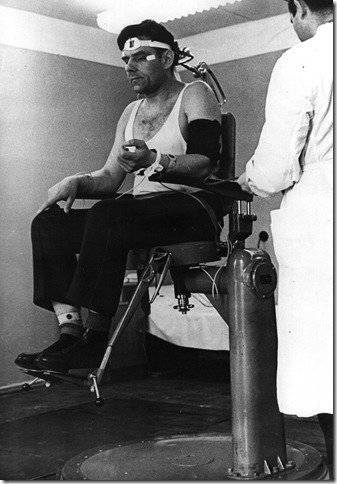
However, Komarov’s career in the cosmonaut detachment did not develop at first, he was twice suspended from preparing to fly for health reasons: first, after an operation for inguinal hernia, then - due to the appearance of a single extrasystole on an electrocardiogram during a centrifuge training. Komarov was a resolute and strong-willed person, a real communist, he always put the interests of society above his own and did not succumb to difficulties. That is what will allow him to eventually return to the current group of astronauts, after six months of training according to his own program in the middle of 1963. In part, Komarov’s restoration to the active composition of the astronauts was due to the recent dismissal for disciplinary reasons of Grigory Nelyubov, the most experienced in the detachment from those who did not fly into space. Grigory Nelyubov - another sad page of the Soviet cosmonautics, the collapse of his career after a ridiculous incident, will lead him to deep depression, problems with alcohol and, ultimately, suicide, but this is completely different story.
17 September Komarov was included in the group for a long solitary flight on the ship "Vostok". However, the low flight characteristics of the Vostok ships led to the closure of the program. Komarov becomes a candidate for a long-term space flight on the new spacecraft Voskhod-1, which he performed on 12-13 in October on 1964, together with Konstantin Feoktistov and Boris Egorov. It was the world's first multi-seater spacecraft. For the first time in the crew, not only a pilot, but also a ship design engineer and a doctor. The flight crew made without spacesuits, a few years later, it will also play a role in the already another tragedy of the Soviet cosmonautics.
The orbit is significantly lower than the calculated one and the drag on the upper layers of the exosphere did not allow the crew to perform the planned long-term flight. The duration of stay in space was a little more than a day. Still, it was a success, a flight into space, a star of a hero, a private car, national recognition. Subsequently, Komarov’s appointment as Soyuz-1 commander was largely due to the fact that he was one of the few astronauts with a higher engineering education and had already been in space.
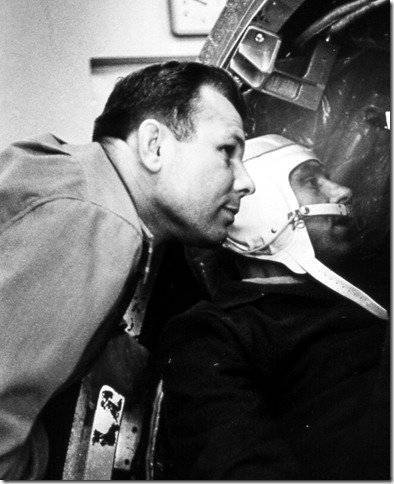
“From my point of view, it is very good that Komarov was entrusted with the execution of such a complex task. The choice is very good. This is a highly educated, highly trained cosmonaut. It is necessary to emphasize that he will not only carry out the program as a pilot-cosmonaut, but as a person who has become an expert in his field in several years of space training. Engineering space profile has become a profession for him. This detail is very important, given the nature of the current assignment. "
Mission parameters
Despite not debugged technology, it was believed that an experienced astronaut would be able to cope with possible malfunctions in orbit. Conceived bold flight program. At the three-seater Soyuz-1, Komarov starts, after a day, Soyuz-2 joins it in orbit with the crew of Bykovsky, Eliseev and Khrunov. Soyuz-1 performs orbital rendezvous and docking with Soyuz-2. Eliseev and Khrunov through open space (the docking stations at that time were not tight yet) go into the ship of Komarov, and everyone is landing. Flight preparation begins more than six months before the flight, as early as September 1966, however, due to the failures of unmanned launches, there is no final decision on whether the flight will take place. 17 April 1967 of the year to the cosmonaut corps comes General Designer Vladimir Mishin. He, too, in a difficult situation, on the one hand, the leadership of the CPSU demands results, on the other hand, a manned launch on a ship with a mass of unsolved technical problems is a big risk. After the death of Korolev, the post of general designer, the former deputy is given a hard time, he does not enjoy great prestige both among his colleagues and the party leadership, but he is trying to please both of them, and he is frankly afraid to take responsibility. Mishin proposes to abandon manned flight and try to dock automatically. However, Komarov insists on manned docking, because at that time the automatic procedure of the Igla system was not worked out, the cosmonaut performed the final approach on the simulator, therefore the chances of success of the unmanned mission were small. Incidentally, this refutes the claim that Komarov did not want to fly on Soyuz-1, he said that he knew that flying on an untested ship doomed him to death and flew only to protect Yuri Gagarin, his close friend. But this is not so, then everyone in the cosmonaut detachment was torn into space, despite the risks, including Gagarin himself, who was extremely dissatisfied with his role as an honorary cosmonaut. The next day, on the advice of the general designers, Komarov would once again express his thoughts on the complexity of a fully automatic docking and many would support him. As a result, the mission is approved to conduct docking in semi-automatic mode and flight with the crew. On April 20, the state commission made the final decision: the launch of the Soyuz-1 spacecraft would be performed on 23 on April, 3 hours 35 minutes Moscow time, and Soyuz-2 on the next day, 24 April, on 3.10. The conditions for the termination of the flight at the stage of the Soyuz-1 operation were also indicated - this is the failure of the Eagle approach system and the failure of the solar panels.
Release
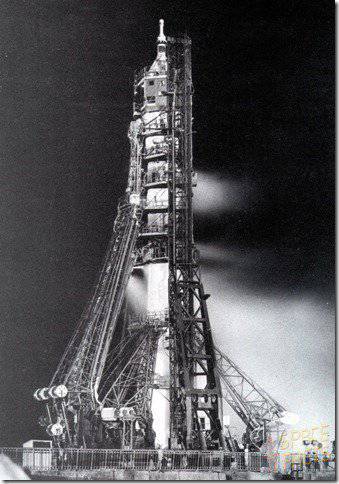
The launch of Soyuz-1 took place on the night of April 23, on 3: 35 Moscow time.
Orbit parameters
Apogee 221,1 km
Perigee 203,1 km
Inclination 51,72 °
Period of circulation 88,45 min
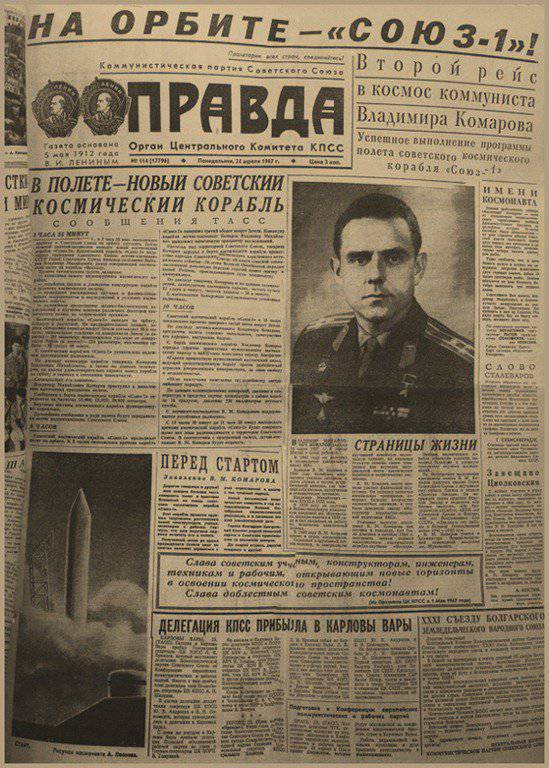
The rocket carrier worked out normally, but immediately after it went into orbit, problems began. The duplicating antenna of the telemetry system did not open and the star orientation system failed, but these were trifles compared to the unfolded solar panel. The recommendations of the MCC, to orient a workable panel to the sun, were unsuccessful, due to the non-disclosure of the second panel, the ship’s balance was violated. Therefore, neither automatically nor manually, it was impossible to orient the remaining panel to the sun. The charge of the ship’s batteries began to fall. On the ground, the question immediately arose whether it was possible in such conditions to successfully complete the flight program and dock with the Soyuz-2. Various solutions were proposed: Komarov went out into open space in order to manually troubleshoot the battery (however, such a procedure had never been worked out before, Komarov was alone in the device, and before that, the Soviet Union had only one experience of going into outer space - cosmonaut Leonov ship "Voskhod-2"). The second proposal - the launch of the Soyuz-2 with two crew members, the transfer of Komarov to the Soyuz-2 and the return to the Soyuz-2, such a decision could save the planned flight program, but it was not known what problems the “ Soyuz-2 ”, if the ship already in orbit was already practically inoperative. It later emerged that Soyuz-2 had the same problems with the parachute system as Soyuz-1. After some hesitation, the state commission made a decision: to cancel the start of the second ship and return the first ship to Earth as soon as possible. In a losing ship, Komarov was faced with a real danger of being killed in orbit. It was precisely the total de-energization of the spacecraft systems that was perceived as the main threat to the life of the astronaut, in this case the connection with the earth and the ability to go out of orbit would be lost, and given the height of the orbit, the life support system simply would not have had enough time to wait for natural inhibition of the exosphere. Nobody even thought about possible problems with the parachute system at the time, the control center and the pilot himself had the task to land the ship. At 17, Komarov tried to orient the ship to a retrograde maneuver, but the main star orientation system did not work due to a sensor malfunction, and the backup ionic one was unstable on the night side. As a result, Soyuz-1 launched a turn on 18, during which Komarov was able to orient the ship on the day side in an emergency mode, fix the orientation by the gyro system and perform a maneuver of de-orbit over the night side with a little manual refinement. The cosmonaut Pavel Belyaev, the crew commander of the Voskhod-2, helped him with this advice, and after the failure of the automation, he also had to plant the device manually. On the 19 circuit, the braking system was started, but due to the disrupted ship balancing, it only worked for 146 seconds from the set 150, the gyros noted a deviation above 8 degrees and blocked the engine. However, it was already unimportant, the ship safely descended from orbit, in the MCC rejoiced, despite the failure of the main mission and technical problems, the pilot was safely returned to the ground. When the connection with the cosmonaut was broken, it did not surprise anyone. When entering the dense layers of the atmosphere, air molecules are heated and ionized, enveloping the descent vehicle with a layer of plasma that shields radio signals. It was expected that the astronaut would contact after landing, an additional antenna was built into the parachute slings, but it often failed.
Emergency situation
The ship’s accident occurred at an altitude of 9.5 kilometers when the barometric sensor issued a command to output the main parachute. At the same time, the parachute is packed in a special container on the capsule, the squibs shoot off the lid of the container from which the exhaust parachute comes out, it pulls the braking parachute, then the timer counting down the 17 seconds is activated, after which the landing capsule speed is sufficiently lowered, the blockage is released and the braking parachute slings pull over the main case. The exhaust and braking parachutes stretched out successfully, but the main exit did not occur. The speed of the descent vehicle remained near 50-70 m / s (near 200-300 km / h), which is quite a bit compared to orbital speeds. At this moment, Komarov was the first to understand that the parachute system was something wrong, both by its own sensations and by sensors in the cockpit. The non-detached deceleration parachute violates the aerodynamic characteristics of the descent vehicle, which begins to rotate rapidly (the vehicle may be twisted due to a ballistic decrease in the atmosphere). Komarov is taking the last thing left for him - activates a reserve parachute, while the squibs must separate the fastenings for the main parachute, this happens, but it does not matter, as the unopened main parachute sits in the container, not letting it go, separates the braking one. The reserve parachute opens, and the speed of the device begins to fall, but almost immediately the lines of the dangling brake parachute wind around the backup dome and quench it. This is the end, Komarov remains to live no more than 3 minutes. The last system, which can slow down the fall of the apparatus, is the engines of a soft landing, but because of the too high rate of descent of the system they did not have time to work. However, they still could not save Komarov: solid-fuel engines were designed to slow down the landing module at a speed of about 10 m / s on the main parachute to 2-3 m / s, and the descent vehicle moved several times faster.
A blow to the ground and an overload of the order of 200 G instantly killed Komarov and flattened the capsule. The impact force was such that a crater was formed, and the wreckage of the ship went half a meter to the ground. The remains of the fuel in the orientation system caught fire. Local residents who were close to the crash site tried to shower the burning debris with earth, but concentrated hydrogen peroxide burned, and finally managed to put out the fire only half an hour later when the rescue team dropped by parachute from a helicopter arrived.
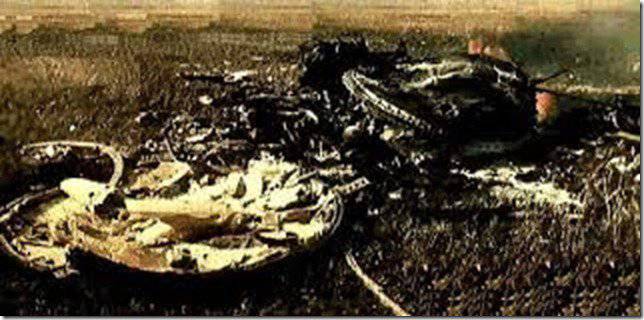
The monstrous overloads and the subsequent fire completely destroyed the instruments and the pilot's body. Fragmented remains of Komarov were able to extract only an hour later. Prior to that, an orientation was taking place that Komarov was not found in the capsule, and nearby hospitals are being checked. Obviously, this is due to the radiogram of the rescue group: "The pilot needs urgent medical assistance in the field," at that time the Soviet cosmonautics did not have an open code designating the death of the astronaut, it will appear later - "1 code."
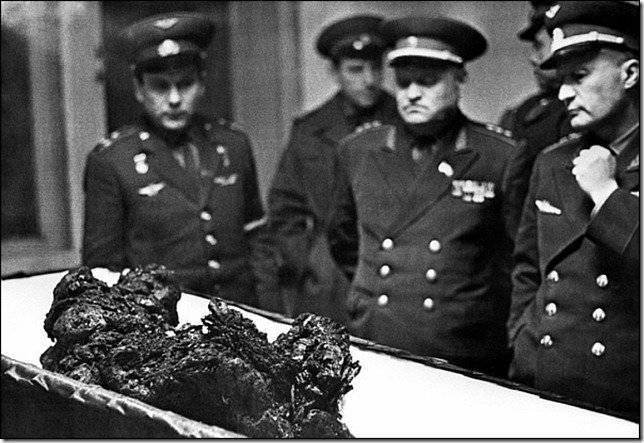
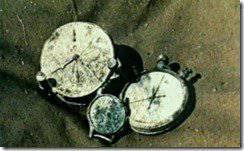
The funeral. Two graves of Vladimir Komarov
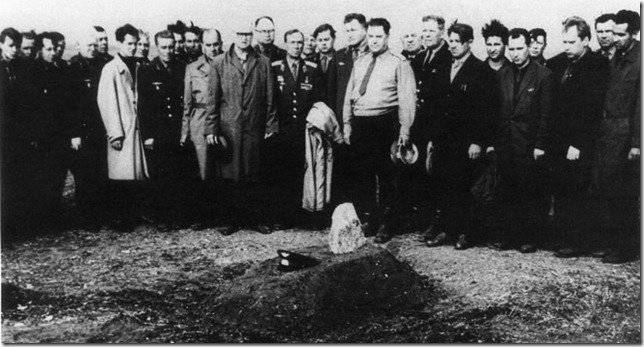
Due to the severe destruction of the ship’s structures and the strong fragmentation of the remains, after removing all the large fragments of Komarov’s body and debris from scientific instruments, they were taken to Moscow for analysis and burial. But at the crash site they found more body fragments and smaller fragments of the apparatus they buried at the crash site. Someone from the participants put his cap on the formed mound.
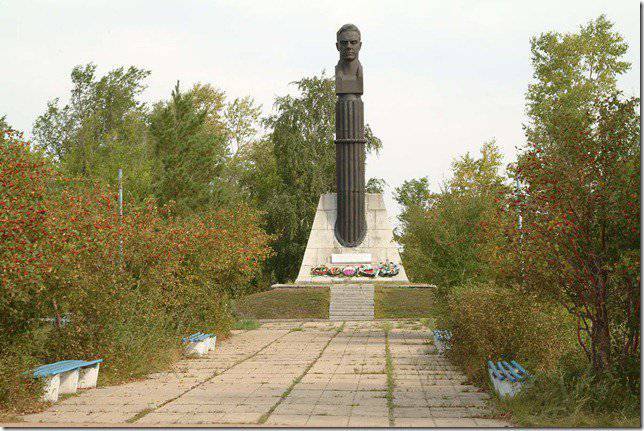
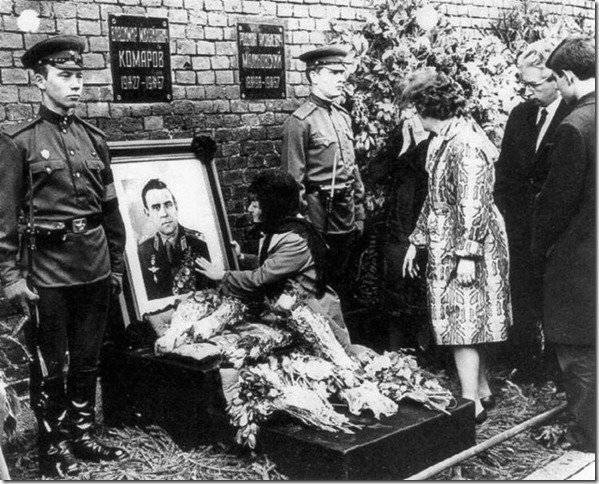
It was impossible to hide the cosmonaut’s death, as they had managed to publicly state the flight. Therefore, the torso, fragments of the skull and limbs were immersed for a magnificent funeral in the Kremlin wall. On April 25, Suslov, Keldysh and Gagarin spoke at the mourning rally from the podium of the Mausoleum. An urn with the ashes of Komarov was installed in a niche of the Kremlin wall.
Thus, the remains of Vladimir Komarov are unevenly divided between two graves. One part is cremated and is in the Kremlin wall. And the other part is buried at the site of the tragedy, where 11 June 1967 was erected a monument.
On someone's initiative, the astronaut's widow was given a very strange death certificate for Komarov, which did not reflect the true cause of death. The certificate stated: extensive body burns; place of death: the city of Schelkovo. This document deeply insulted Valentin Komarov and Yuri Gagarin. As a result, the certificate was rewritten, stating: “... tragically died when the test flight was completed on the Soyuz-1 spacecraft.
Causes of what happened.
The restoration of the picture of the incident greatly complicated the fact of the almost complete destruction of the descent vehicle. All that the experts were able to establish was that the squibs responsible for the withdrawal of the main and reserve parachutes worked in flight, and not from hitting the ground or the subsequent fire. After analyzing all versions, the commission concluded that the blocking of the parachute by the container was caused by a pressure drop that deformed the walls of the package. However, this conclusion was not confirmed by flight tests of test samples of the descent vehicle, in which no such incidents were noted. The parachute and the emergency 7K-OK No. 1 normally opened. Much later, in his memoirs, Boris Chertok will write that the most likely cause of a parachute malfunction was a violation of the styling technique when applying an ablative heat shield. The finished descent vehicle was placed in a special chamber, where a ceramic coating was applied to the surface of the ship in a liquid form, then the descent vehicle was subjected to high temperature to polymerize the coating. Very similar to the glazing of pottery. At the same time, the parachute container covers for the Soyuz-1 and 2 were not ready; an improvised replacement was made for them, which probably was not tight enough. The effect of temperature and condensation of very sticky vapors of heat shield materials on the shell and the parachute also caused its blockage inside the container. In an unofficial experiment conducted by engineers, the descent vehicle of the non-flying Soyuz-2 was hung from the main parachute slings on a crane, trying to figure out how to develop an effort to remove the parachute from the container. To the surprise of the participants in the experiment, even when the descent vehicle completely hung on the lines, the parachute did not exit. They did not report to the commission on the investigation of these results, as it had the most serious consequences for the participants of the parachute installation team and the installation of a heat shield. As a result, the size of parachute containers was increased and the problems with the withdrawal of parachutes from the "Union" never again arose.
Myths and stupidity surrounding the life and death of Komarov.
1. Even before the flight, Komarov knew that he was doomed to death and flew only under pressure from the leadership, as well as trying to protect his friend Yuri Gagarin, who was his understudy
Tests of the new experimental ship and the space flight itself are associated with the risk to life, which Komarov was aware of. Nobody put pressure on Komarov, he himself spoke out for flying with the crew. This was the case to which he devoted the last 6 years of his life. Komarov's daughter recalls that shortly before the start in the family and with friends, the astronaut spoke skeptically several times about the chances of flying for success, but it is not clear whether he meant the designated mission objective (docking and transfer of crews through open space) or just a catastrophe. As for Yuri Gagarin, even if Komarov had suddenly abandoned the mission, Gagarin, most likely, would not have gone anywhere. The admission of Gagarin to the flights was under the jurisdiction of the Central Committee of the CPSU and just so politically important is the figure, especially in such a complex test flight, no one would let go. Even the appointment of Gagarin as Komarov's double was taken very skeptically for this very reason. In fact, Kohmarov had no substitute.
2. Komarov was suspended from flying due to extrasystoles, which required an operation to remove the tonsils to remove.
Strangely enough, this absurd statement is often found in articles about Komarov and Soyuz-1. Komarov was suspended from flying after an operation for an inguinal hernia. Nobody deleted his tonsils, besides there is no connection between extrasystoles and removal of the tonsils.
3. Komarov burned on entry to the atmosphere due to a malfunction of the heat shield.
Probably the origins of this myth lie in the emergency landing of unmanned 7K-OK No. 3 and in the strong thermal destruction of Komarov’s remains, which are not similar to ordinary fire damage. High-temperature combustion of concentrated hydrogen peroxide is significantly different from a conventional fire. We can say with confidence that until the contact with the ground Komarov was alive and controlled the ship, since the backup dome of the descent vehicle was manually activated.
4. During the descent, Komarov swore obscenely and cursed the MCC operators and engineers who sent him a suicide bomber on a faulty ship..
The fall rate of the descent vehicle was not reliably established; visual observation from aerial reconnaissance aircraft showed a speed of the order of 30-60 m / s so, theoretically, Komarov, depending on the speed of fall, had about 2-3 minutes from the moment of awareness of the emergency until of death. However, he could not conduct radio communications, since the antenna was located in the lines of the main parachute, which was just like that. The question remains somewhat controversial: was such an antenna built into the lines of the backup dome? In modern Soyuz-TM there is an antenna, but whether it was part of Soyuz-1 is unknown, at least I did not manage to find this information. In addition, by the time the reserve parachute opened, even if the FM transmitter had already been built into it, the height was already about 5-6 kilometers, with such a height, the radio signals do not spread far enough so that they can be received in other countries. But even if Komarov had a technical opportunity in the last 60-90 seconds of his life to go on the air, it is extremely doubtful that foul language and insults would have become his last words. At least, everything in his life, the nature and circumstances of the mission contradicts this. It is very likely that the last words of Komarov remained in the recording of the onboard voice recorder, but after the catastrophe the film could not be restored, as was the film of the Mir-3 device with the ship’s telemetry records.
Consequences for Soviet cosmonautics
The death of the Soyuz-1, was reflected primarily in the general designer Vasily Mishin, with great difficulty given crucial decisions, he is cautious, afraid to send people into space. Therefore, despite the technical possibility of a manned flyby of the Moon on the Zond program and the protests of the Lunar cosmonauts group, turtles flew to the Moon instead of people. We can confidently say that the catastrophe that interrupted Komarov’s life predetermined in many ways the defeat of the Soviet Union in the lunar race.
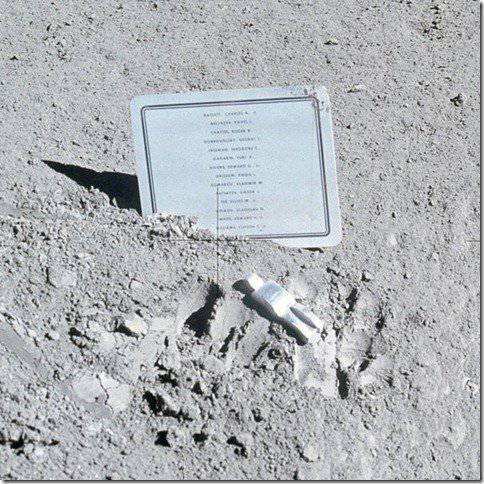
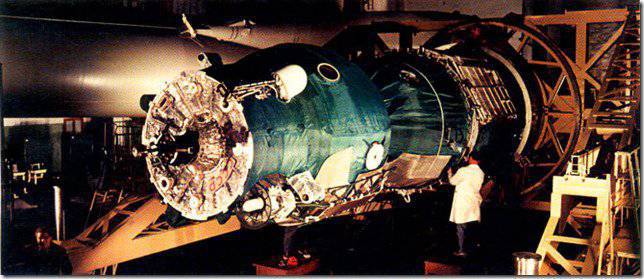
The piloted flights of the Soyuz program were postponed almost to 2 of the year, and in the 1968 year, when they resumed, shortly before the launch of Soyuz-4 and Soyuz-5, which nevertheless carried out Komarov’s mission to dock and transfer the crew , NASA has already tested the Apollo-7 system in low earth orbit. Before the first landing of Americans on the moon remained less than a year. The death of the Soyuz-1, along with a series of failures with the creation of the H-1 rocket, a defeat in the Moon race and the death of the Soyuz-11 crew, will eventually lead to the dismissal of Mishin from the position of General Designer in 1974. The period of Mishin’s leadership by many in the space industry is still extremely negative. As the most unsuccessful in the Soviet cosmonautics, in fact, destroyed the heritage of Korolev, and his dream of flying into deep space.
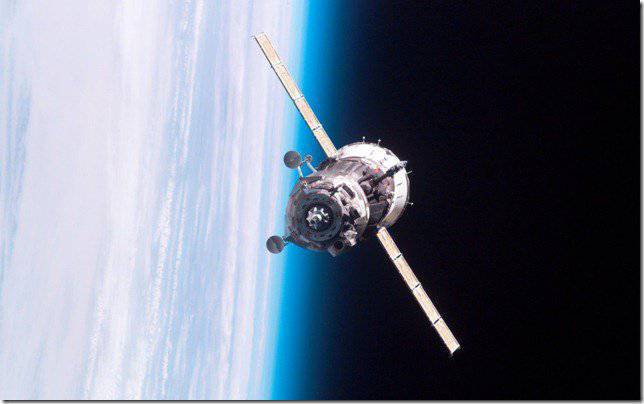
Despite the closure of the Soviet Lunar program, the Soyuz spacecraft and its unmanned version of Progress, eventually, became one of the most successful serial disposable spacecraft in the world, both are successfully used to date.
Information